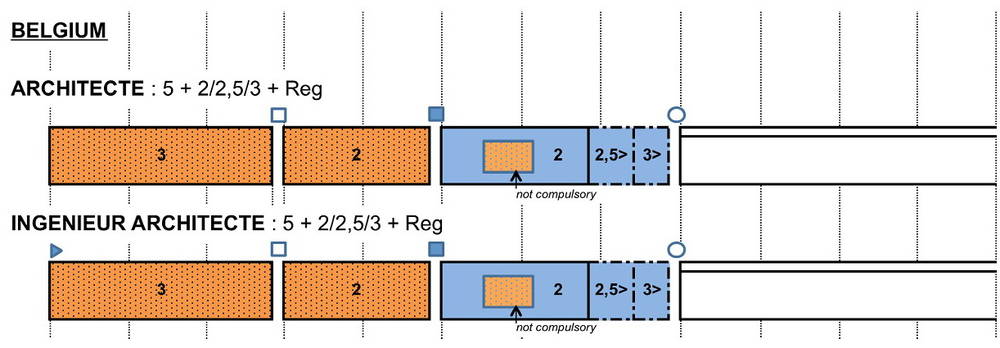
- News
- Publications
- Press releases
- Links
- Contact
- Members area
 Conseil National de l'Ordre des Architectes (CNOA)
Conseil National de l'Ordre des Architectes (CNOA)19/4, Rue des Chartreux- 1000 Bruxelles
Phone: + 32 2 627 88 10
Fax: + 32 2 627 88 19
Email: nationale.raad(at)cnoa-nroa(dot)be / conseil.national(at)cnoa-nroa(dot)be
Website: www.ordredesarchitectes.be
 Fédération Royale des Sociétés d'Architectes de Belgique (FAB)
Fédération Royale des Sociétés d'Architectes de Belgique (FAB)Rue Ernest Allard, 21 - 1000 Bruxelles
Phone: + 32 2 512 34 52
Fax: + 32 2 502 82 04
Email: info(at)fab-arch(dot)be
Website: www.fab-arch.be

| Protection of the title of architect | Yes |
| Protection of the function of architects | Yes |
| Professional title | Architect or Architect-engineer |
| Mandatory Registration | Yes |
| If yes, Where ? | FR: Conseil National de l’Ordre des Architectes (CNOA) / NL: Nationale Raad van de Orde van Architecten –(NROA) |

Show the legend
• Bachelor 3 years + Masters 2 years
• Final examination of the academic training giving access to the diploma
• 2 Years Professional training (compulsory) - Possibility of extension (additional 6 months or 1 year if necessary)
| Additional compulsory practical training- internship | 2 Years (can be extended 6 months or 1 year) |
| Requirement for undertaking a period of traineeship | Yes. Art. 50,51, 52 Law June 26th 1963 on the installation of the Order of Architects |
| Period of traineeship supervised (overseen) | Yes
|
| By who | Conseil National de l’Ordre des Architectes (CNOA) |
| Practical training period | 24 months (minimum + 6 months or 1 year if necessary) with period of 6 months minimum |
| Where? To which conditions? | Architect’s office Maximum 2 trainees per mentor Employers - mentors need to be registered |
| Number of hours per month required | 120 hours per month |
| Compulsory Professional examination | No |
| Complementary professional education | No |
| Remuneration of the Traineeship | Yes (12-19 €/hour gross) |
| Trainee accompanied | Yes by a provincial council member of the Order |
| Specific supplementary courses organised | No |
| Model form of contract available | Yes, it is provided when enlisted on the list of trainees |
| Traineeship and practical experience undertaken abroad taken into account experience | Yes |
| Evaluation of the Traineeship | Yes, every 6 months and at the end |
| Evaluation method used | - Submission of certification that the traineeship has been succesfully completed - Evaluation every six months at the provincial council of the order - Presentation of a portfolio at the end of the traineeship |
Additional notes:
- On the francophone side, each of the Superior Institutes of Architecture (ISA) have joined since September 2010 a university within a new department (faculty) of architecture. The Architect-engineers, for their part, belong (like other engineers) to faculties of Applied Sciences (except at the UCL where they have joined the new department of Architecture).
- On the Flemish side, the Institutes of Architecture were integrated in the (multidisciplinary) “grandes écoles”, while Architect-engineers are trained by three universities.
- Civil engineers working in construction can also practise as architects if they have carried out their professional internship of two years (but they are not recognized at European level).
- In some local Councils (level of Belgian “province”), specialised internships (for example in a company) or certain training courses can sometimes be taken into account as part of the work experience (6 months maximum). The internship must be monitored by an internship mentor that complies with the legal requirements.
- It must be pointed out that from the beginning of his/her traineeship, the trainee can already take some personal project in charge.
Are Architects obligation to carry insurance? | YES |
Legal Basis: | Art. 2, §4 Law of February 20th 1939 on the protection of the title and on the profession of architect. |
What are the requirements for obtaining Insurance? |
|
How are insurance premiums calculated? | Up to the insurance companies to decide |
What forms of Insurance contract exist: | 10 years (counted from acceptance) + non-contractual liability of 20 years. |
Insurances / Agents: |
| Does a system of CPD for architects exists in your country ? | Yes |
| If yes: - Is it compulsory ? - Is it encouraged ? - Is it free ? | It is not yet compulsory. It is encouraged, participation is voluntarily. Most of the organisations, who are offering CPD, charge a fee for participation. |
| If it is compulsory, is it required by law, or by a Code of Conduct ? | |
| If it is regulated, who regulates the system: a professional body, a governmental body, a combination of the two ? | Once regulated, the regulation will be taken in charge by the NROA and the CNOA |
| Is it organised ? | YES. On a regional scale (NROA and CNOA) |
| Who provides the courses: | Professional organizations, law firms, private companies etc. |
| What level of training is provided: | General awareness (keeping up to date), Regulations and legislation, Professional expertise, Local issues, etc. |
| Are certain subjects mandatory ? | Not really, off course courses have to be related to the profession |
| What types of activities or provisions are accepted : | - Courses - Readings - Seminars - Trainings - Excursions - Educations - Symposiums - Workshops |
| Do you have any evaluation criteria for the CPD material ? | No |
| Who recognize (accredits) these trainings : | A team of council members (per region NROA and CNOA) |
| Development of the trainings : A. Estimated number of courses / year B. Estimated number of participants / y C. Estimated lesson hours / year | Differs by activity/organisation: A - Some activities/trainings are organized once a year - Some activities/trainings are held once. - Some activities/training are organized a few times a year. B Depending on the activity/organisation C Depending on the activity/organisation |
| Level of requirements for the architects : | Not yet determined |
| Is this required level validated or checked and how: A. Not requested, B. Self-assessment of value, C. Attendance tracking, D. Self-assessment using self-test, E. By regular checks, F. Examination, G. Thesis, H. Others means (e.g. electronic monitoring) ? | C. Attendance tracking E. By regular checks, |
| Is training (provision) delivered abroad accepted ? | Yes |
| What kind of sanction is applied for the non-compliance with CPD obligation: A. none, B. Reprimand, C. Expulsion from the register, D. Other ? | |
| Do you have a database of the content of your CPD Programme ? | YES, we provide a free platform in which an overview of acknowledged courses can be consulted. |
What requirements must a European architect fulfil to practice in this country?
|
Required documents: For Permanent establishment in Belgium the architect has to register with the Provincial Council of the Order of Architects competent for the chosen location for the exercise of the profession |